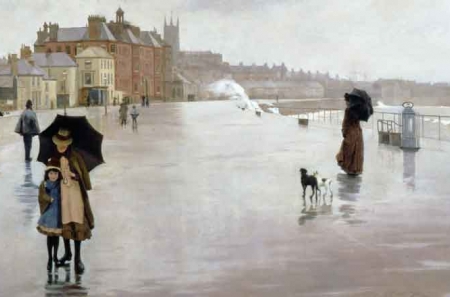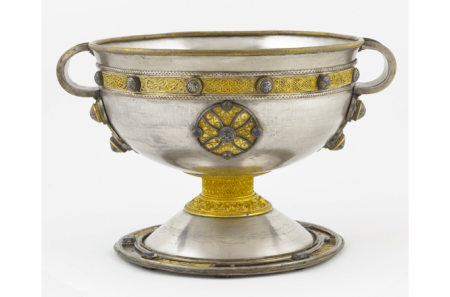
Modern Ireland in 100 Artworks: Sive, John B. Keane
12 September 2015Sive by John B. Keane, 1959
This week’s entry is Sive by John B. Keane. Noted as one of the greatest plays of the 20th century, it is Keane’s most famous play.
‘The force that Keane unleashed on the Ireland of the late 1950s was one against which it had no protection, because it came not from the new ideas of urban intellectuals but from the depths of a dying tradition’.
Read the full article here
You can read more about John B. Keane’s life and work in the Dictionary of Irish Biography:
Keane, John B.
by John A. Murphy
Keane, John B. (1928–2002), writer, humorist, and publican, was born 21 July 1928 at Church St., Listowel, Co. Kerry, fourth child among five sons and four daughters of William Keane and Hannah Keane (née Purtill). The initial ‘B.’ stood for Brendan, a name taken on confirmation after St Brendan (qv) the Navigator. An older brother,Eamonn (qv) (d. 1990), became a distinguished actor.
Education and early life William Keane, principal of Clounmacon national school three miles (4.8 km) from Listowel, kept well-stacked bookshelves, and John B. became familiar through his beloved father with the classics and nineteenth-century English literature and, in particular, with the characters of Charles Dickens. He imbibed patriotism and a store of Irish and English songs from his mother Hannah, a small farmer's daughter from Ballydonoghue, who in her youth had been a member of Cumann na mBan and the Gaelic League. During summer vacations, the schoolboy became immersed in the immemorial rural life of his father's ancestral country, the remote Stack's Mountains between Listowel and Castleisland. The colourful culture, characters, and speech (a Hiberno-English mingling of Gaelic and Elizabethan English) of this area were to be a dominant influence on the future playwright's creations.
He was educated at Listowel national school and at the local secondary school and diocesan seminary, St Michael's College, whence (according to himself) he ‘was expelled several times – for smoking, speech-making, ballad-writing, and play-acting’ (quoted in Hogan, 15). One traumatic experience was being beaten by a priest-teacher for having the presumption in an elocution class to recite verses he had composed himself. During his schooldays John B. expressed his passion for playing Gaelic football as well as his blossoming talent for writing and staging concerts. Having left school after completing his leaving certificate, he spent some time in various occupations such as fowl-buying and serving as a pharmacist's apprentice.
In January 1952 he took the emigrant boat from Dún Laoghaire and worked for two years in different jobs in Northampton, classifying himself as a ‘buck-navvy’. His temporary exile, during which he continued to write, affected him deeply, giving him a first-hand appreciation of the personal tragedy and degradation of involuntary emigration. The experience was to feature centrally in his plays, but also made him realise that his true physical and imaginative home was his native North Kerry. Returning to Ireland, he worked for some time as a pharmacist's assistant in Doneraile and in his home town, Listowel. He married Mary O'Connor early in 1955 and they purchased the Greyhound Bar at 37 William St., where he was to live and work for the rest of his life.
Playwright He developed a pattern of writing into the small hours after the pub had closed. A light radio play, ‘Barbara Shearing’, was accepted by Radio Éireann but it was ‘Sive’, a startling melodrama, that first brought him recognition. Rejected by the Abbey Theatre (a reflection, perhaps, of the comprehension gap between the Dublin cognoscenti and the pre-modern rural culture of the far south-west), it was first presented in Walsh's ballroom, Listowel, on 2 January 1959 by the Listowel Drama Group. It played to packed audiences in various Munster venues before winning the All-Ireland Amateur Drama Festival at Athlone in April. (The amateur drama movement was one of the redeeming features of the otherwise bleak social scene in the Ireland of the 1950s.) ‘Sive’ then gained Dublin ‘respectability’ when it was produced on 25 May 1959 at the Queen's Theatre, the Abbey's temporary home after its own premises were destroyed by fire. Meanwhile, Keane had formed an agreement with the Southern Theatre Group (STG), an important development giving him an independent professional base in Cork. It was the STG that produced his next play, ‘Sharon's grave’ (also rejected by the Abbey), on 1 February 1960, as well as much of his subsequent work.
If Keane was the most popular playwright of the twentieth century, ‘Sive’ was the most popular and the most frequently performed (a favourite of amateur dramatic societies) of his score of plays. What accounted for its remarkable appeal? The plot develops in lurid fashion the familiar rural story of the tragic mismatch between an innocent young girl and an old man, organised by her greedy relatives and the scheming matchmaker. The entertainment is at once deepened and lightened by the tinkermen, Pats Bocock and his son Carthalawn, with their Greek-chorus commentary on the sad tale, excoriating with bodhrán and song those who have destroyed Sive. The raw violence of plot and language gripped audiences who, with the shock of recognition, appreciated the starkness and savagery behind the generally sanitised idyll of rural society. As they moved into modern Ireland after mid-century, Keane's public applauded the accurate and realistic portrayal of a now dying culture.
Critics of plays like ‘Sharon's grave’ (1960) claimed, with some justification, that Keane's scenes and character were bizarre and grotesque, exemplified in the physically and mentally warped hunchback Dinzie Conlee being carried around on the back of his brother Jack. ‘Sharon's grave’ and other plays evoke the folk superstitions of a pagan past. Yet Keane's stagecraft made this outlandish world plausible and compelling.
Various dramatists – Dion Boucicault (qv), J. M. Synge (qv), T. C. Murray (qv), Paul Vincent Carroll (qv), George Shiels (qv), M. J. Molloy (qv), Walter Macken (qv) – have been suggested as inspirational influences on Keane's work, but there seems to be little conscious awareness of theatrical models in his approach. It should also be said that the powerful social dramas of his productions were often played down for laughs to audiences expecting an undemanding night's entertainment.
A stream of plays followed ‘Sive’ and ‘Sharon's grave’. These included the effective music-drama ‘Many young men of twenty’ (1961), a poignant and trenchant commentary on the evils of emigration; ‘The highest house on the mountain’ (1961), where the characters struggle with their sexual demons; ‘The man from Clare’ (1962), with its portrait of a veteran footballer coming to terms with himself and those around him; ‘The year of the hiker’ (1963), depicting the tension between the wandering hero and his settled family; ‘Big Maggie’ (1969) – in which the title role was written for the actress Anna Manahan – about a formidable, outspoken widow, determined to protect her interests in a hostile world; and the poorly received ‘Moll’ (1971), a farcical piece about a priest's housekeeper. There is general agreement among students of Keane's work that his portrayal of female characters – Aunt Mena in ‘Sive’, Big Maggie, Maimie Flanagan in ‘The field’ – is impressively convincing.
‘The field’ (1965) is generally considered to be his best play, and its central figure, the Bull McCabe, to be one of the most memorable characters in the history of Irish theatre. Based on a notorious Kerry murder case, the elemental passion of ‘The field’ is land, with the menacingly obsessive McCabe prepared to resort to murder to prevent the field he covets from falling into the hands of a ‘modernising’ outsider. At a deeper level, Keane is dramatising the tension between the survivalist, self-preservatory instinct of people like McCabe and the powerful codes of state, church, and the law. The play was ill served by a vulgar, Hollywoodised screen version in 1990.
Other writings and awards While the output of Keane plays fell away from the 1970s, with a corresponding deterioration in quality, his classic creations continued to be brought by professional companies to wider national and international audiences (‘Big Maggie’ was performed off Broadway in 1983 and ‘The field’ in Moscow in 1988). Meanwhile, Keane's creative talents were flowing in other directions. One of his earliest publications had been The street and other poems in 1961, followed by his Self-portrait in 1964. From the late 1960s to the late 1970s, he produced an incisive, entertaining, and popular series of fictional ‘letters’, by way of shrewd comment on Irish politics and society. Letters of a successful TD (1967) was followed by similar epistolary dispatches from a parish priest, a publican, a ‘love-hungry farmer’ (rural loneliness and sexual deprivation are familiar Keane themes), a civic guard, a country postman, a minister of state, and a matchmaker. He was fascinated by matchmakers, particularly the real-life Dan Paddy Andy O'Sullivan who was the subject of a book in Irish in 1977, later translated as Man of the triple name (1984). Keane wrote short stories and essays as well as newspaper columns, and he made regular contributions to radio and television, his commentaries on social issues being courageous and provocative. His novels included The bodhrán makers (1986); Durango (1992), described as a manic Kerry ‘western’; and The contractors (1993). Indeed, his critics would claim that he was far too prolific.
In his later years the formal custodians of culture belatedly conceded him those accolades long conferred by the plain people. He was appointed to the arts council and was made a member of Aosdána. In 1998 the Abbey Theatre made amends for its earlier rejection by presenting him with the Gradam medal for his contribution to Irish theatre. In January 1999 he received the lifetime achievement Irish PEN/A. T. Cross prize from President Mary McAleese. There were honorary degrees from Dublin University, Marymount College, Manhattan, and the University of Limerick. He was particularly pleased at being named the 1990 Kerry Person of the Year by the Kerry Association in Dublin – ‘the most important award I have ever received’. His home town named a John B. Keane Road in his honour. Meanwhile, the pub in William St. became a place of pilgrimage for literary figures and aspiring young writers, to whom he generously dispensed help and counsel.
Assessment The playwright's attachment to his native town and county was highly significant. In verse and song, he celebrated Listowel and its Feale river, and he was keenly aware of the remarkable literary heritage of the area. Other writers either reject their home place or pay it mere sentimental tribute. But Listowel gave Keane rootedness, security, and continuity, strength and assurance: from the town and its hinterland, and indeed from the customers of his own public house, he drew affection, inspiration, and inexhaustible source-material for his work.
Proceeding from an unfashionably happy childhood, he found contentment and fulfilment in his wife Mary, his children and relations, the easy company of his friends, and the community which he cherished and which cherished him in turn. He was literally the genius loci, the presiding genial local deity. Fame and success did not affect his personality, behaviour, or lifestyle, and he continued to speak and sing in his melodious native woodnotes wild. He particularly cultivated the image of homespun philosopher and whimsical storyteller. Humour and laughter were of the essence of the man and his work: the earthy humour of rural Ireland, the humour of human foibles, and the quirky humour that comes from the deliberate juxtaposition of the mundane and the exotic. Yet he had a strong and serious social conscience, expressed both in his work and in his political views, for he was deeply interested in politics and current affairs. He railed against sexual prudery, hypocrisy, corruption in public life, and what he saw as indifference to such tragedies as emigration. He had the intellectual strength, independence, and courage, rare in his time and place, to unwrap the hereditary faith-and-fatherland package, inspect the contents critically, and transcend them while not rejecting them. His was the positive criticism of the insider, but in an age of conformism this did not spare him an often hostile reaction. He challenged sexual puritanism and petty clerical tyrannies, but cherished his religious faith. He opposed the GAAban on foreign games, yet Gaelic football for him was a passionate expression of his feeling for the locality and the nation. As a leading member of the anti-compulsion Language Freedom Movement in the 1960s, he was smeared as a shoneen and a ‘West Brit’, yet the Irish language was an essential part of his being. He rejected ‘republican’ terrorism but nobody could gainsay his patriotism.
John B. Keane cannot be classified as a modern or post-modern playwright of contemporary Ireland. He did not deal with the then fashionable aspects of the Irish human condition – alienation or identity crisis. He did not wrestle with identity problems, perhaps because he had no problems about who he was.
The society that he reflected in his plays has vanished. A field-fixated Bull McCabe would hardly be a credible figure in early twenty-first-century Ireland. What Keane did vividly and brilliantly was to articulate a culture in transition, catching its brutality, melodrama, and semi-paganism and yet presenting its perennial larger themes and evoking its timeless humanity.
John B. Keane married (5 January 1955) Mary O'Connor of Knocknagoshel, fourth child of Cornelius O'Connor and Bridget Lane. They had three sons, Billy, Conor, and John, and one daughter, Joanna. He died at his home in William St., Listowel, on 30 May 2002, and is buried in the old cemetery there. His manuscripts and papers are deposited in TCD library.
John B. Keane, Self-portrait (1964); Robert Hogan, ‘The hidden Ireland of John B. Keane’, Éire-Ireland, iii, no. 2 (1968), 14–26; ITWW; Gus Smith and Des Hickey, John B.: the real Keane (1992; new ed. 2002, containing bibliog.); The best of John B. Keane: collected humorous writings (1999); North Kerry Literary Trust, John B. Keane, playwright of the people: a collection of tributes (2004); obituaries and appreciations in Irish and British newspapers after his death; personal acquaintance



